#Return of Dr. Mabuse
Text
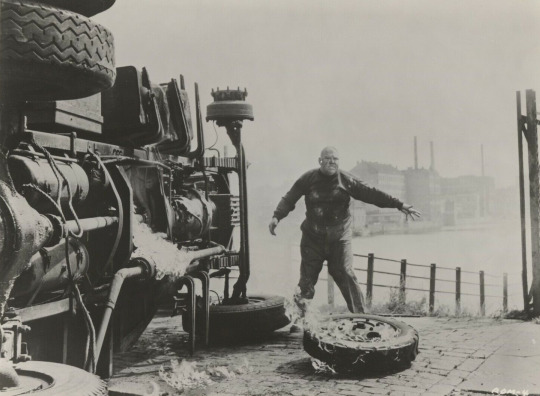
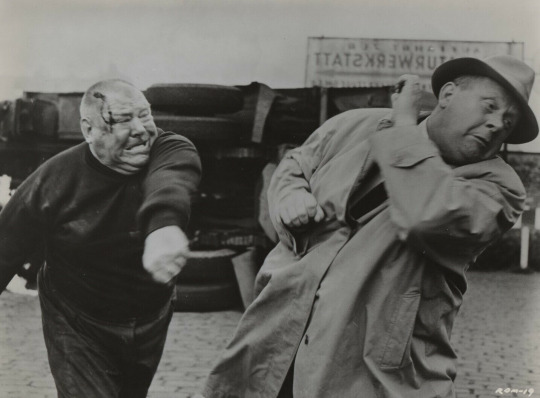
Ady Berber and Gert Fröbe in The Return of Dr. Mabuse (Im Stahlnetz des Dr. Mabuse, 1961)
#lm stahlnetz des dr. mabuse#the return of dr. mabuse#gert fröbe#ady berber#1960s movies#harald reini#krimi
22 notes
·
View notes
Photo

Gustaf Gründgens in M (Fritz Lang, 1931)
Cast: Peter Lorre, Ellen Widman, Inge Landgut, Otto Wernicke, Theodor Loos, Gustaf Gründgens, Friedrich Gnaß, Fritz Odemar, Paul Kemp, Theo Lingen, Rudolf Blümner, Georg John, Franz Stein, Ernst Stahl-Nachbaur. Screenplay: Thea von Harbou, Fritz Lang. Cinematography: Fritz Arno Wagner. Art direction: Emil Hasler, Karl Vollbrecht. Film editing: Paul Falkenberg.
Point of view is everything in a thriller. Let the viewer see events through the wrong eyes, and suspense goes out the window. The remarkable thing about Lang's great thriller is that the point of view changes so often. It starts with that of anxious parents, knowing that a child-killer is on the loose, then narrows to one particular parent, waiting for her daughter to come home from school for lunch. But then we see the object of her fears, her daughter, making contact with a strange man, and our suspense builds as we return to the worried mother. But as strongly as we sympathize with the mother, we also eventually learn to focus our anxieties elsewhere: on the beleaguered police, on innocent victims of people's suspicions, on the criminal underworld harassed by the police, and eventually even on the murderer himself. There are even moments when, as he becomes the object of the manhunt, trapped in the attic of a building swarming with the criminals in search of him, we find ourselves semi-consciously rooting for him to escape. Then we find ourselves rooting for the criminals to capture him and to escape being caught by the cops. And then, when he is put on trial by the criminals, we root for the police to arrive and rescue him. In short, the movie is a study in the ways in which sympathy can be manipulated. Lang and his soon-to-be-ex-wife Thea von Harbou wrote the screenplay, and the atmosphere of the film is superbly maintained by the cinematography of Fritz Arno Wagner and the sets of Emil Hasler and Karl Vollbrecht. But none of it would work without the presence of some extraordinary performers, starting with Peter Lorre as the sniveling, obsessed Hans Beckert: a career-defining performance in many ways, considering that Lorre had been known for comic roles on stage before Lang made him a movie star. Then there's Otto Wernicke as Inspector Lohmann, whose performance was so memorable that Lang brought him back as the same character in The Testament of Dr. Mabuse (1933), stereotyping Wernicke as a cop for much of his career. And Gustav Gründgens, the imperious leader of the criminal faction, who later became identified with the role of Mephistopheles in stage and screen versions of Goethe's Faust (Peter Gorski, 1960) -- not to mention in Klaus Mann's 1936 novel, Mephisto (and István Szabó's 1981 film version), based on Gründgens's embrace of the Nazis to advance his career.
14 notes
·
View notes
Text
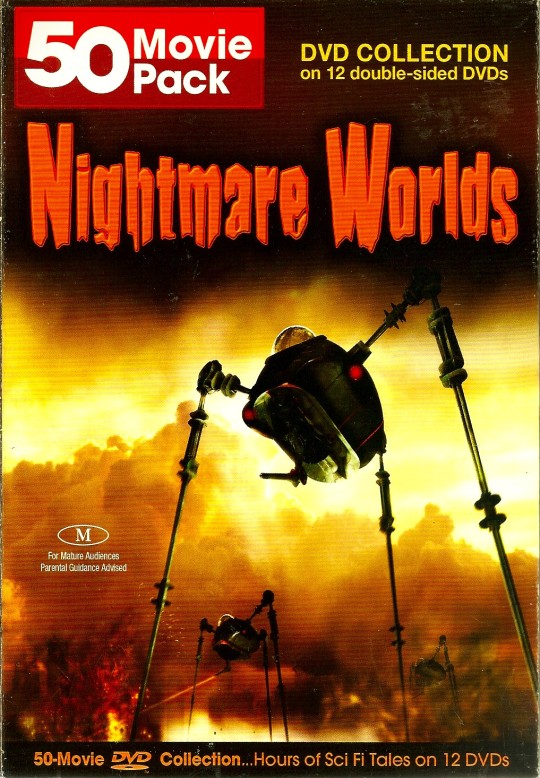
Bad movie I have Nightmare Worlds I have to break this set up so you well see this box 2 or 3 times it has Menace from Outer Space 1956, The Mistress of Atlantis 1932, Night Fright 1967, The Nightmare Never Ends 1980, Panic aka Bakterion 1982, The Phantom Creeps 1939, Piranha Piranha 1972, Prisoners of the Lost Universe 1983, Purple Death from Outer Space 1966, Radio Ranch aka The Phantom Empire 1935, and Return of Dr. Mabuse 1961
#Menace from Outer Space#Richard Crane#The Mistress of Atlantis#Brigitte Helm#Night Fright#John Agar#The Nightmare Never Ends#Cameron Mitchell#Panic#David Warbeck#The Phantom Creeps#Bela Lugosi#Piranha Piranha#William Smith#Prisoners of the Lost Universe#Richard Hatch#Purple Death from Outer Space#Buster Crabbe#Radio Ranch#Gene Autry#Return of Dr. Mabuse#Gert Frobe
2 notes
·
View notes
Text
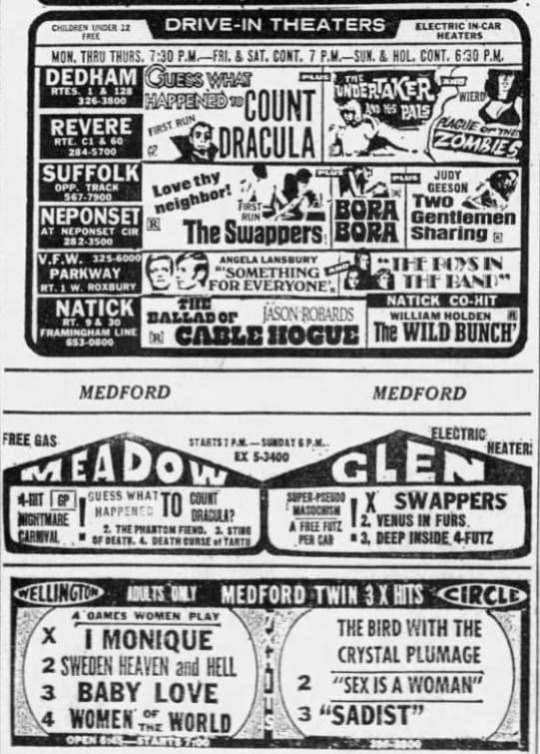
the area where the Meadow Glen drive in was once located is currently my super market 😀
«11-6-70, Boston suburbs - Another classic Drive In listing includes GUESS WHAT HAPPENED TO COUNT DRACULA? with THE UNDERTAKER AND HIS PALS and Hammer's PLAGUE OF THE ZOMBIES at the Dedham and Revere. The main feature was also with Bill Grefe's STING OF DEATH and DEATH CURSE OF TARTU plus Harald Reinl's THE PHANTOM FIEND (THE RETURN OF DR. MABUSE, 1961) at the Meadow Glen.
Check out the Medford Twin for "more of the usual" meaning more of the good stuff you usually see in these ads including titles like THE SADIST, BIRD WITH THE CRYSTAL PLUMAGE, SWEDEN HEAVEN AND HELL, and WOMEN OF THE WORLD! The Meadow Glen's other screen included FUTZ and Jess Franco's VENUS IN FURS.»
8 notes
·
View notes
Text
My WVUD playlist and stream, 7/9/2022
Yamila - Visions II
Kate Bush - Running Up That Hill (TOTEM remix)
xPropaganda - The Wolves Are Returning
Propaganda - Dr. Mabuse
New Order - Shellshock
Face To Face - Under the Gun
Until December - We Are the Boys (Single Version)
SPK - Metal Dance
Jonah Mutono - Modern Love
Zombi - Captain of Her Heart
Unwoman - Careless Whisper
Robert Minott - I Want to Know What Love Is
Petridisch - Don't Be Greedy (feat. Leah Callahan)
Cristina - Drive My Car
Krisma - Nothing To Do with the Dog
Quando Quango - Low Rider (Exclusive Remix)
Gina X Performance - Be a Boy
Rockets - On the Road Again
Simple Minds - Celebrate
Depeche Mode - Personal Jesus
James Brown - Living In America
Time Zone - World Destruction
Was (Not Was) - Wheel Me Out
(listen on Mixcloud)
7 notes
·
View notes
Text
A-T-4 040 Propaganda - Dr. Mabuse
When it comes to ZTT it's easy to imagine Trevor Horn having complete control everything the label released and Paul Morley masterminding the A Level art inspired vision of the pop product. One of ZTTs earliest signings Propaganda also had pretensions to be more of a conceptual project inspired by cinema than your regular pop group that Morley saw as a great fit for him and the label. Of course this was nothing new the likes of Devo were doing this in 1977. Morley hoped to be more esoteric in it's (A Level art) references whilst making commercially successful pop
Ralf Dörper co-founded Propaganda after leaving German industrial noise band Die Krupps. There's a great interview with him in Electronic Sound
"Dörper was [...] amused to note how Paul Morley’s high-art, densely detailed packaging often proved an obstacle outside Britain...
“The further away we went from London and the Morley campaigns, the more successful it was,” chuckles Dörper. “It failed totally in the US, though. We were filming a video for ‘p:Machinery’ in New York and the record company out there couldn’t understand anything Morley said about how he wanted to do to promote it."
I'm thinking about this because ZTT put out so many versions of Dr. Mabuse. The villainous Dr. Mabuse created by Norbert Jacques was made famous by German filmmaker Fritz Lang in his films Dr. Mabuse the Gambler, The Testament of Dr. Mabuse, and The Thousand Eyes of Dr. Mabuse. There are two variations of the sleeve artwork for the Propaganda single and it was also put out in a generic ZTT sleeve, the 'White Hand' sleeve is based on the film poster for another Fritz Lang film, M
The original releases of Dr. Mabuse was available in 5 mixes across at least 15 product variations. More recent collections gather together around 16 remixes, both released and previously unreleased
Dörper claims being a German band recording in the UK had a negative impact on their reception in Germany but Dr. Mabuse still got into the top 10 there, in fact it did better in West Germany than elsewhere (it got to 27 in the UK). The follow-up Duel was also a big hit across Europe but took 13 months to be released because ZTT was preoccupied with cultivating the success of Frankie Goes To Hollywood
Dr. Mabuse became a staple for DJs in Ibiza making it onto many balearic lists. The 1000 Eyes of Dr. Mabuse (Volume 1) (named after Fritz Lang's return to the character of Dr. Mabuse, it will also be his last film) will be released for RSD 2024
Propaganda - Dr Mabuse (Master Mix For Germany)
youtube
Dr. Mabuse (Special Instrumental Mix)
youtube
0 notes
Text
Medic fav movies:
-A zed and two noughts
-dr mabuse the gambler + the testament of dr mabuse. And Metropolis while we're at it. Easy to say but. I do think he has a healthy appreciation for fritz lang
-On a similar note: loves the original cabinet of dr caligari and also the weird 60s remake of it that you can't find anywhere with equal fervor
-Experiment in terror
-Decoder (1984) like as in the throbbing gristle movie
-World on a wire
Knowledgeable on film and has interests that range far and wide but is generally pretty reserved regarding it. Will watch all sorts of shit with Heavy and occasionally Engineer when the time is right but I think for the most part when the suggestion to watch a movie comes up he just tries to convince everyone to watch like pimple popping compilations
Heavy fav movies:
-Also really easy to say but Stalker bc cmon. And Mirror, Solaris, Andrei Rublev, etc
-The Ascent (1977)
-Welcome or no trespassing (1964).
-Underground (1995)
-The like 4 different war and peace movies by sergey bondarchuk
-And yknow what I think he'd fucking love Farewell my concubine and I feel very assured in this
Spy fav movies:
-Purple Noon -- I think he has reasonably seen/read and enjoyed other works related to tom ripley but this is the only one I'm certain about. Like cmon now.
-The red shoes
-The discreet charm of the bourgeoisie LOL
-Les Vampires AND Irma Vep
-General hitchcock fan and I think his fav movie of his is Rope. Like. Ok. I'm sorry. But it has to be this way
-The taking of pelham 123 the seventies one
-Fucking reservoir dogs, somehow. Bonds with scout over this
He WILL look down on everyone else for their choices of favorite Hitchcock movies even if he likes them too (he does, generally) because he thinks everyone else's reasons for liking what they do are worse than his. gets really distracted and upset thinking about this
Scout fav movies:
-DRIVE
-PULP FICTION
-FIGHT CLUB
-RESERVOIR DOGS AGAIN
-AMERICAN PSYCHO
-SHAUN OF THE DEAD (bonds with Spy over this one too. Spy goes like ''the editing of this is nauseating and the characters are unpleasant'' but as they continue watching they both get like, really sad and guilty. spy moreso. i havent seen shaun of the dead)
Demoman:
I think that at some point when he was a TEEN his mom was like. Cmon lad. You haven't got any hobbies. You're wasting away here. So he found time in between his like 3-5 jobs to take a theater class at a high school he did not go to and they just let him until his CURSED EYE started wreaking havoc on the place. He never pursued his dreams of theater again but I imagine he loves wtaching like, shakespeare adaption movies and thinking about how he would have done a better job.
-likes chimes at midnight, othello, and hamlet from orson welles
-ran+othello+the bad sleep well
-Conversely also really fucking loves like. Steel magnolias. and fried green tomatoes and shit
-All time favorite movie is Muriel's Wedding for some reason
Sniper:
-Genuinely, earnestly. Loves crocodile dundee with all his heart. And at some point someone else who he'd been in a spat with puts it on in hopes it would offend him but it makes him cry. from joy. because he loves it
-Similar feelings towards mad max. watches it and goes like. oh god. this is just like my life
-Fav hitchcock is vertigo
-Fistful of dollars trilogy (bonds with engie over this) + once upon a time in the west
-Fucking. Butch cassidy and the sundance kid LOL
-Seven samurai and also like literally every movie that could be considered a remake of it in some form regardless of quality
-Night/Dawn/Day of the dead. AND return of the living dead and furthermore the completely unrelated City of the living dead
Engineer movies:
-Shares in the sergio leone appreciation with sniper. Likes once upon a time in america, but not once upon a time in the west, which is the opposite of how sniper feels
-Touch of evil
-One flew over the cuckoo's nest
-My darling clementine
-David and lisa
-The swimmer
Soldier owns two movies, which are:
-A version of American Sniper cut down to like 20 minutes and dubbed over with weird fucked up voices but he thinks it's the original and he loves it. He thinks it's beautiful and it makes him cry
-An incomplete VHS recording of dr strangelove including television commercials that just has clips from the very beginning and end. This one also makes him cry
Pyro:
Has seen every single movie mentioned here and thinks they are all beautiful. Also has a tape of the wicker man that is in such horrendous quality that it's rendered completely unintelligible to anyone else. They like to watch the end
Not meant to be a modern setting or anything I'm just choosing to believe that the existence of australium led to a domino effect ending with every single movie on this list that otherwise wouldn't exist yet being made in the 1960s with no changes. And VHS tapes and DVDs are both part of a lucrative enterprise that will never die
#genuinely apologize for the state of my blog right now. but#if i'm being honest the first thing i did upon waking up was think about this in the shower for like 30 minutes#also thanks to hal for coming up with quite a bit of this#tf2
0 notes
Text
The Eye of the Camera
When examining the relationship between the camera and the story being told on screen, there’s two distinct possibilities for how the filmmakers and director of photography can approach it. When speaking about Italian Neorealism in the 1940s and 50s specifically, Leo Longanesi, a journalist, and Cesare Zavanetti, a scriptwriter, spoke on their feelings that “reality can be captured by returning the camera's eye to its primary function as a machine that merely documents, without altering or manipulating, the material that passes before its lens.” Their point certainly stands when you look at films like Alfred Hitchcock’s Lifeboat and Sarah Polley’s Women Talking. Each of these stray away from using complex film techniques, and almost always are filming the action and dialogue on an unmoving camera, the way it would be seen by the human eye. Despite these films being released nearly 80 years apart, and the technological advancements that are accessible to films being made in the present day, when looking at the awards received by each film, it’s plain to see that this has and will always be a viable method of storytelling on screen. Lifeboat received 3 nominations from the Academy Awards, including Best Cinematography. Women Talking received a nomination for Best Picture at the Academy Awards, as well as winning for Adapted Screenplay.

However, this rule isn’t by any means hard and fast. Plenty of films, both older and newer, portray the story in more creative ways than Longanesi and Zavanetti believed film should be told. Take 1993’s The Testament of Dr. Mabuse and 2022’s Elvis. Both use unique camera movements, placements, and techniques to get inside the mind of the characters. This provides a more psychological connection with the people on screen, as opposed to the more empathetic connection that the prior method provides. Both are critically acclaimed in the modern day, with Elvis being nominated for Best Cinematography at the Academy Awards. As such, both techniques and methods clearly work, it’s a matter up to the cinematographer and director to decide which way to go.
-Haley Ruccio
Bondanella, Peter. “Three Neorealist Classics by Vittorio De Sica.” Cinéaste 23, no. 1 (1997).
0 notes
Text
'Dark City' – The Flop Roger Ebert Loved Dearly
Alex Proyas’ “Dark City” seems like a warmup for a number of the biggest existentialist thrillers to return.
Proyas’ 1998 movie shortly turned a cult favourite after a failed theatrical launch (extra on that later) however comes throughout as a starter dish for the luxurious style meals proper across the nook.
By fusing the visuals and themes of Fritz Lang (significantly his “M” and “Dr. Mabuse”)…
View On WordPress
0 notes
Text
Fritz lang - testament of dr mabuse
Romans Harris
Curby
Modiano Suspended sentences
Carib expo at Tate
LRB
Hiroshima mon amour
Trumph of the will, riefenstal
Under the volcano, Lowry
The goalie‘s anxiety, handke
Galgut - 3 voyages
Batman
Anthea Hamilton & Ukraine @ HKA antwerp, middelheim
Liberty bar, maigret, Simenon
Left-handed woman, Handke
My own private Idaho - van sant
Better call Saul season 7
Savage detectives
Julius caesar film
Stange something - Damon gadget
McClure: mostfegh
Raise the red latern
Dead ringers film
Colomina - health
Books of Jacob
Free Ypi
Everything all at once
Bolano return
Bolano last night on earth
Crusaders - Dan Jones
Maigret - l’affaire saint fiacre
Fountains Abbey
Rawdon
Kidderminster
Nidderdale
0 notes
Text
So since like...Metropolis is in the spotlight because of a certain post. Here's some history on why it was concidered lost for so long:
Alfred Hugenberg, a German nationalist businessman, cancelled UFA's debt to Paramount and Metro-Goldwyn-Mayer after taking charge of the company in April 1927, and chose to halt distribution in German cinemas of Metropolis in its original form. Hugenberg had the film cut down to a length of 3,241 metres (about 118 minutes), broadly along the lines of Pollock's edit, removing the film's perceived "inappropriate" communist subtext and religious imagery. Hugenberg's cut of the film was released in German cinemas in August 1927. Later, after demands for more cuts by Nazi censors, UFA distributed a still shorter version of the film (2,530 metres, 91 minutes) in 1936, and an English version of this cut was archived in the Museum of Modern Art (MoMA) film library in the 1930s. It was this version which was the basis of all versions of Metropolis until the recent restorations. In 1986 it was recopied and returned to Germany to be the basis of the 1987 Munich Archive restoration.
It takes like 3 seconds to look up Wikipedia for this. Also from Wikipedia:
According to Lang, propaganda minister Joseph Goebbels called Lang to his offices to inform him – apologetically – that The Testament of Dr Mabuse was being banned but, nevertheless, he was so impressed by Lang's abilities as a filmmaker (especially Metropolis), that he offered Lang the position of head of German film studio UFA. Lang said it was during that meeting he had decided to leave for Paris – but that the banks had closed by the time the meeting was over.
And this blurb about the complete cut from the aforelinked Metropolis wiki article:
The negative was a safety reduction made in the 1960s or 1970s from a 35 mm positive of Lang's original version, which an Argentinian film distributor had obtained in advance of arranging theatrical engagements in South America.
The TL;DR of it is this: 1. The film was brought over in the late 1920s. And 2. IF the Nazi's were involved in any way, it would probably just be the censored cut of the film and not the full version of it. Also it's probably safe to assume that the Nazi's only saw the cut up version of the film and would probably write it off as leftist propaganda if their reaction to The Testament of Dr. Mabuse was any indication.
Anyway, does Argentina have a bad history? Yes.
Does Germany have a bad history? Also yes.
This isn't meant to be like...a denouncement of all the war crimes and other stuff that has happened in those two countries' pasts. But what this post is about is it only takes two seconds to do your own research on film history. Especially when something says something like "we don't know how it got there, it's a mystery!". Just because the answer seems clear, probably means it's not.
14 notes
·
View notes
Photo

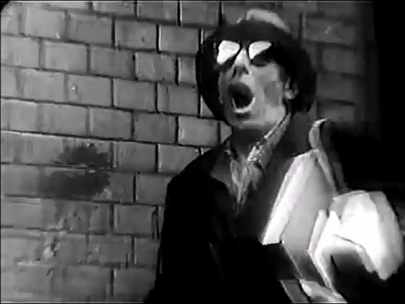


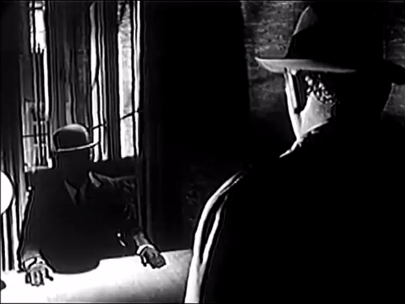
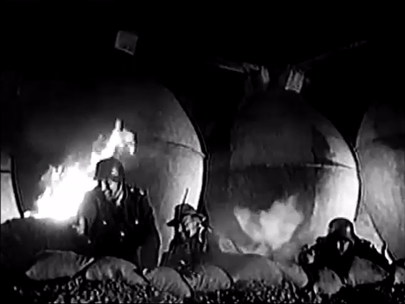
The Return of Dr. Mabuse [Im Stahlnetz des Dr. Mabuse] (1961)
Dir: Harald Reinl
Personally, I thought this was a pretty terrible B-Movie with a few interesting sequences.
2 notes
·
View notes
Text
Utopia and Apocalypse: Pynchon’s Populist/Fatalist Cinema

The rhythmic clapping resonates inside these walls, which are hard and glossy as coal: Come-on! Start-the-show! Come-on! Start-the-show! The screen is a dim page spread before us, white and silent. The film has broken, or a projector bulb has burned out. It was difficult even for us, old fans who’ve always been at the movies (haven’t we?) to tell which before the darkness swept in.
--from the last page of Gravity’s Rainbow
To begin with a personal anecdote: Writing my first book (to be published) in the late 1970s, an experimental autobiography titled Moving Places: A Life at the Movies (Harper & Row, 1980), published in French as Mouvements: Une vie au cinéma (P.O.L, 2003), I wanted to include four texts by other authors—two short stories (“In Dreams Begin Responsibilities” by Delmore Schwartz, “The Secret Integration” by Thomas Pynchon) and two essays (“The Carole Lombard in Macy’s Window” by Charles Eckert, “My Life With Kong” by Elliott Stein)—but was prevented from doing so by my editor, who argued that because the book was mine, texts by other authors didn’t belong there. My motives were both pluralistic and populist: a desire both to respect fiction and non-fiction as equal creative partners and to insist that the book was about more than just myself and my own life. Because my book was largely about the creative roles played by the fictions of cinema on the non-fictions of personal lives, the anti-elitist nature of cinema played a crucial part in these transactions.`
In the case of Pynchon’s 1964 story—which twenty years later, in his collection Slow Learner, he would admit was the only early story of his that he still liked—the cinematic relevance to Moving Places could be found in a single fleeting but resonant detail: the momentary bonding of a little white boy named Tim Santora with a black, homeless, alcoholic jazz musician named Carl McAfee in a hotel room when they discover that they’ve both seen Blood Alley (1955), an anticommunist action-adventure with John Wayne and Lauren Bacall, directed by William Wellman. Pynchon mentions only the film’s title, but the complex synergy of this passing moment of mutual recognition between two of its dissimilar viewers represented for me an epiphany, in part because of the irony of such casual camaraderie occurring in relation to a routine example of Manichean Cold War mythology. Moreover, as a right-wing cinematic touchstone, Blood Alley is dialectically complemented in the same story by Tim and his friends categorizing their rebellious schoolboy pranks as Operation Spartacus, inspired by the left-wing Spartacus (1960) of Kirk Douglas, Dalton Trumbo, and Stanley Kubrick.
For better and for worse, all of Pynchon’s fiction partakes of this populism by customarily defining cinema as the cultural air that everyone breathes, or at least the river in which everyone swims and bathes. This is equally apparent in the only Pynchon novel that qualifies as hackwork, Inherent Vice (2009), and the fact that Paul Thomas Anderson’s adaptation of it is also his worst film to date—a hippie remake of Chinatown in the same way that the novel is a hippie remake of Raymond Chandler and Ross Macdonald—seems logical insofar as it seems to have been written with an eye towards selling the screen rights. As Geoffrey O’Brien observed (while defending this indefensible book and film) in the New York Review of Books (January 3, 2015), “Perhaps the novel really was crying out for such a cinematic transformation, for in its pages people watch movies, remember them, compare events in the ‘real world’ to their plots, re-experience their soundtracks as auditory hallucinations, even work their technical components (the lighting style of cinematographer James Wong Howe, for instance) into aspects of complex conspiratorial schemes.” (Despite a few glancing virtues, such as Josh Brolin’s Nixonesque performance as "Bigfoot" Bjornsen, Anderson’s film seems just as cynical as its source and infused with the same sort of misplaced would-be nostalgia for the counterculture of the late 60s and early 70s, pitched to a generation that didn’t experience it, as Bertolucci’s Innocents: The Dreamers.)
From The Crying of Lot 49’s evocation of an orgasm in cinematic terms (“She awoke at last to find herself getting laid; she’d come in on a sexual crescendo in progress, like a cut to a scene where the camera’s already moving”) to the magical-surreal guest star appearance of Mickey Rooney in wartime Europe in Gravity’s Rainbow, cinema is invariably a form of lingua franca in Pynchon’s fiction, an expedient form of shorthand, calling up common experiences that seem light years away from the sectarianism of the politique des auteurs. This explains why his novels set in mid-20th century, such as the two just cited, when cinema was still a common currency cutting across classes, age groups, and diverse levels of education, tend to have the greatest number of movie references. In Gravity’s Rainbow—set mostly in war-torn Europe, with a few flashbacks to the east coast U.S. and flash-forwards to the contemporary west coast—this even includes such anachronistic pop ephemera as the 1949 serial King of the Rocket Men and the 1955 Western The Return of Jack Slade (which a character named Waxwing Blodgett is said to have seen at U.S. Army bases during World War 2 no less than twenty-seven times), along with various comic books.
Significantly, “The Secret Integration”, a title evoking both conspiracy and countercultural utopia, is set in the same cozy suburban neighborhood in the Berkshires from which Tyrone Slothrop, the wartime hero or antihero of Gravity’s Rainbow (1973), aka “Rocketman,” springs, with his kid brother and father among the story’s characters. It’s also the same region where Pynchon himself grew up. And Gravity’s Rainbow, Pynchon’s magnum opus and richest work, is by all measures the most film-drenched of his novels in its design as well as its details—so much so that even its blocks of text are separated typographically by what resemble sprocket holes. Unlike, say, Vineland (1990), where cinema figures mostly in terms of imaginary TV reruns (e.g., Woody Allen in Young Kissinger) and diverse cultural appropriations (e.g., a Noir Center shopping mall), or the post-cinematic adventures in cyberspace found in the noirish (and far superior) east-coast companion volume to Inherent Vice, Bleeding Edge (2013), cinema in Gravity’s Rainbow is basically a theatrical event with a social impact, where Fritz Lang’s invention of the rocket countdown as a suspense device (in the 1929 Frau im mond) and the separate “frames” of a rocket’s trajectory are equally relevant and operative factors. There are also passing references to Lang’s Der müde Tod, Die Nibelungen, Dr. Mabuse, der Spieler, and Metropolis—not to mention De Mille’s Cleopatra, Dumbo, Freaks, Son of Frankenstein, White Zombie, at least two Fred Astaire and Ginger Rogers musicals, Pabst, and Lubitsch—and the epigraphs introducing the novel’s second and third sections (“You will have the tallest, darkest leading man in Hollywood — Merian C. Cooper to Fay Wray” and “Toto, I have a feeling we’re not in Kansas any more…. –Dorothy, arriving in Oz”) are equally steeped in familiar movie mythology.
These are all populist allusions, yet the bane of populism as a rightwing curse is another near-constant in Pynchon’s work. The same ambivalence can be felt in the novel’s last two words, “Now everybody—“, at once frightening and comforting in its immediacy and universality. With the possible exception of Mason & Dixon (1997), every Pynchon novel over the past three decades—Vineland, Against the Day (2006), Inherent Vice, and Bleeding Edge—has an attractive, prominent, and sympathetic female character betraying or at least acting against her leftist roots and/or principles by being first drawn erotically towards and then being seduced by a fascistic male. In Bleeding Edge, this even happens to the novel’s earthy protagonist, the middle-aged detective Maxine Tarnow. Given the teasing amount of autobiographical concealment and revelation Pynchon carries on with his public while rigorously avoiding the press, it is tempting to see this recurring theme as a personal obsession grounded in some private psychic wound, and one that points to sadder-but-wiser challenges brought by Pynchon to his own populism, eventually reflecting a certain cynicism about human behavior. It also calls to mind some of the reflections of Luc Moullet (in “Sainte Janet,” Cahiers du cinéma no. 86, août 1958) aroused by Howard Hughes’ and Josef von Sternberg’s Jet Pilot and (more incidentally) by Ayn Rand’s and King Vidor’s The Fountainhead whereby “erotic verve” is tied to a contempt for collectivity—implicitly suggesting that rightwing art may be sexier than leftwing art, especially if the sexual delirium in question has some of the adolescent energy found in, for example, Hughes, Sternberg, Rand, Vidor, Kubrick, Tashlin, Jerry Lewis, and, yes, Pynchon.
One of the most impressive things about Pynchon’s fiction is the way in which it often represents the narrative shapes of individual novels in explicit visual terms. V, his first novel, has two heroes and narrative lines that converge at the bottom point of a V; Gravity’s Rainbow, his second—a V2 in more ways than one—unfolds across an epic skyscape like a rocket’s (linear) ascent and its (scattered) descent; Vineland offers a narrative tangle of lives to rhyme with its crisscrossing vines, and the curving ampersand in the middle of Mason & Dixon suggests another form of digressive tangle between its two male leads; Against the Day, which opens with a balloon flight, seems to follow the curving shape and rotation of the planet.
This compulsive patterning suggests that the sprocket-hole design in Gravity’s Rainbow’s section breaks is more than just a decorative detail. The recurrence of sprockets and film frames carries metaphorical resonance in the novel’s action, so that Franz Pökler, a German rocket engineer allowed by his superiors to see his long-lost daughter (whom he calls his “movie child” because she was conceived the night he and her mother saw a porn film) only once a year, at a children’s village called Zwölfkinder, and can’t even be sure if it’s the same girl each time:
So it has gone for the six years since. A daughter a year, each one about a year older, each time taking up nearly from scratch. The only continuity has been her name, and Zwölfkinder, and Pökler’s love—love something like the persistence of vision, for They have used it to create for him the moving image of a daughter, flashing him only these summertime frames of her, leaving it to him to build the illusion of a single child—what would the time scale matter, a 24th of a second or a year (no more, the engineer thought, than in a wind tunnel, or an oscillograph whose turning drum you can speed or slow at will…)?
***
Cinema, in short, is both delightful and sinister—a utopian dream and an apocalyptic nightmare, a stark juxtaposition reflected in the abrupt shift in the earlier Pynchon passage quoted at the beginning of this essay from present tense to past tense, and from third person to first person. Much the same could be said about the various displacements experienced while moving from the positive to the negative consequences of populism.
Pynchon’s allegiance to the irreverent vulgarity of kazoos sounding like farts and concomitant Spike Jones parodies seems wholly in keeping with his disdain for David Raksin and Johnny Mercer’s popular song “Laura” and what he perceives as the snobbish elitism of the Preminger film it derives from, as expressed in his passionate liner notes to the CD compilation “Spiked!: The Music of Spike Jones” a half-century later:
The song had been featured in the 1945 movie of the same name, supposed to evoke the hotsy-totsy social life where all these sophisticated New York City folks had time for faces in the misty light and so forth, not to mention expensive outfits, fancy interiors,witty repartee—a world of pseudos as inviting to…class hostility as fish in a barrel, including a presumed audience fatally unhip enough to still believe in the old prewar fantasies, though surely it was already too late for that, Tin Pan Alley wisdom about life had not stood a chance under the realities of global war, too many people by then knew better.
Consequently, neither art cinema nor auteur cinema figures much in Pynchon’s otherwise hefty lexicon of film culture, aside from a jokey mention of a Bengt Ekerot/Maria Casares Film Festival (actors playing Death in The Seventh Seal and Orphée) held in Los Angeles—and significantly, even the “underground”, 16-millimeter radical political filmmaking in northern California charted in Vineland becomes emblematic of the perceived failure of the 60s counterculture as a whole. This also helps to account for why the paranoia and solipsism found in Jacques Rivette’s Paris nous appartient and Out 1, perhaps the closest equivalents to Pynchon’s own notions of mass conspiracy juxtaposed with solitary despair, are never mentioned in his writing, and the films that are referenced belong almost exclusively to the commercial mainstream, unlike the examples of painting, music, and literature, such as the surrealist painting of Remedios Varo described in detail at the beginning of The Crying of Lot 49, the importance of Ornette Coleman in V and Anton Webern in Gravity’s Rainbow, or the visible impact of both Jorge Luis Borges and William S. Burroughs on the latter novel. (1) And much of the novel’s supply of movie folklore—e.g., the fatal ambushing of John Dillinger while leaving Chicago’s Biograph theater--is mainstream as well.
Nevertheless, one can find a fairly precise philosophical and metaphysical description of these aforementioned Rivette films in Gravity’s Rainbow: “If there is something comforting -- religious, if you want — about paranoia, there is still also anti-paranoia, where nothing is connected to anything, a condition not many of us can bear for long.” And the white, empty movie screen that appears apocalyptically on the novel’s final page—as white and as blank as the fusion of all the colors in a rainbow—also appears in Rivette’s first feature when a 16-millimeter print of Lang’s Metropolis breaks during the projection of the Tower of Babel sequence.
Is such a physically and metaphysically similar affective climax of a halted film projection foretelling an apocalypse a mere coincidence? It’s impossible to know whether Pynchon might have seen Paris nous appartient during its brief New York run in the early 60s. But even if he hadn’t (or still hasn’t), a bitter sense of betrayed utopian possibilities in that film, in Out 1, and in most of his fiction is hard to overlook. Old fans who’ve always been at the movies (haven’t we?) don’t like to be woken from their dreams.
by Jonathan Rosenbaum
Footnote
For this reason, among others, I’m skeptical about accepting the hypothesis of the otherwise reliable Pynchon critic Richard Poirier that Gravity’s Rainbow’s enigmatic references to “the Kenosha Kid” might allude to Orson Welles, who was born in Kenosha, Wisconsin. Steven C. Weisenburger, in A Gravity’s Rainbow Companion (Athens/London: The University of Georgia Press, 2006), reports more plausibly that “the Kenosha Kid” was a pulp magazine character created by Forbes Parkhill in Western stories published from the 1920s through the 1940s. Once again, Pynchon’s populism trumps—i.e. exceeds—his cinephilia.
7 notes
·
View notes
Text
2019 Movie Odyssey Awards
As the 2019 Movie Odyssey Award for Best Original Song final was extended, the 2019 Movie Odyssey Awards themselves are late. As always, this is the annual awards ceremony to recognize a year of films that I saw for the first time in their entirety in the calendar year. All films featured - with the exception of those in the Worst Picture category (and even then, the Worst Picture winner won a competitive award below) - are worth seeing.
The full list of every single film I saw as part of the 2019 Movie Odyssey can be seen in this link.
Best Pictures (I name ten winners, none of which are distinguished above the other nine)
The Ascent (1977, Soviet Union)
An Autumn Afternoon (1962, Japan)
BlacKkKlansman (2018)
The Informer (1935)
Kuroneko (1968, Japan)
Once Upon a Time in Hollywood (2019)
Sons of the Desert (1933)
Victor/Victoria (1982)
The Westerner (1940)
Woodstock (1970)
Three of these Best Picture winners received 10/10 from yours truly: The Ascent, Sons of the Desert, and Woodstock. To my discredit, there are - for the second consecutive time - no silent films here. It is also the second consecutive Best Picture lineups without entries from the 1990s or 2000s. This is the first Best Picture lineup without a winner from the 1950s. It is, as a result of my seeing fewer feature-length films than usual this year, the most monolingual Best Picture field in a while. This field of ten runs the gamut of comedy, documentary (Woodstock is only the third documentary of 80 over the last eight years to be a Best Picture winner), horror, musical, American Western, war, family drama, and historical drama.
Best Comedy
Booksmart (2019)
Design for Living (1933)
The Great McGinty (1940)
Jewel Robbery (1932)
Jour de Fête (1949, France)
Sitting Pretty (1948)
Smokey and the Bandit (1977)
Sons of the Desert
Toy Story 4 (2019)
Victor/Victoria
Most of these had me bursting in laughter. Design for Living not Jewel Robbery may not have been gut-burstingly funny, but I appreciate the wittiness of ‘30s romantic comedies and so there get a spot here. Booksmart is the best pure comedy of 2019 and Smokey and the Bandit has been described by a few Southerners of not so much a comedy as it is a documentary of Southern culture in the 1970s. But Sons of the Desert, with Laurel and Hardy’s slapstick mastery, takes it away here. Fun fact: “Sons of the Desert” is the name of the international Laurel and Hardy fan club (its founding documents co-written by Stan Laurel).
Best Musical
Frozen II (2019)
The Happiest Millionaire (1967)
King of Jazz (1930)
Mary Poppins Returns (2018)
The Perils of Pauline (1947)
Rocketman (2019)
Thousands Cheer (1943)
Victor/Victoria
Oh this wasn’t close. Some films here may have packed more songs into their runtime (The Happiest Millionaire and Mary Poppins Returns), others were more fantastical (Rocketman), or dispensed with a plot altogether to concentrate on the music (Thousands Cheer)... but Victor/Victoria felt narratively decades of its time and was bolstered by an outstanding performance by Julie Andrews. Credit to Henry Mancini and Leslie Bricusse for their musical score, too.
Best Animated Feature
Frozen II
Fun and Fancy Free (1947)
How to Train Your Dragon: The Hidden World (2019)
Modest Heroes (2018, Japan)
Toy Story 4
There have been years where some category dries up in its nominees. This year, it was certainly animated feature. The wave of recent non-English language animated films that usually populate this category were severely diminished to just one last year: Modest Heroes. The weakest Toy Story film of the four - note that this bar is extremely high - is your winner, just edging HTTYD.
Best Documentary
The African Lion (1955)
Hale County This Morning, This Evening (2018)
Made in Vietnam (2017)
Minding the Gap (2018)
Pavarotti (2019)
Seadrift (2019)
Walk Run Cha-Cha (2019 short)
While I Breathe, I Hope (2018)
Woodstock
Yellowstone Cubs (1963)
A year that saw yours truly watch many more documentaries than usual sees Woodstock, directed by Michael Wadleigh, as the winner here. Woodstock perfectly immerses the viewer into the totality of the eponymous 1969 music festival of the same name and is one of the great concert films. Runners-up included the experimental Hale County This Morning, This Evening (a collection of contemporary images of black lives in Hale County, Alabama) and the excellent Minding the Gap (an observational glimpse into the lives of three friends from Rockford, Illinois who are all drawn to skateboarding and a devastating portrait of youth and masculinity in America) - both Oscar nominees and both shown on PBS earlier in 2019.
Congratulations to Walk Run Cha-Cha for being the first short film nominated in this category since 2015. I first saw it as part of the curatorial committee on Viet FIlm Fest this year and this New York Times film is now shortlisted as a potential Best Documentary Short Film nominee for the 92nd Academy Awards.
Best Non-English Language Film
The Ascent, Soviet Union
An Autumn Afternoon, Japan
Barnali (1963), India
The Garden of Mr. Vong (2017 short), Germany
Ginger and Fred (1986), Italy
Jour de Fête, France
Kuroneko, Japan
La Pointe Courte (1955), France
Pitfall (1962), Japan
Song Lang (2018), Vietnam
I may have seen fewer non-English language films this year, but there’s still a great selection here. In what was essentially a choice between The Ascent or An Autumn Afternoon, the only 10/10 recipient is the winner here. Vietnam has its first appearance in this category with Leon Le’s Song Lang - which is still making the film festival circuits.
Best Silent Film
Bobby Bumps and His Pointer Pup (1916 short)
Bobby Bumps at the Dentist (1918 short)
Bobby Bumps, Chef (1917 short)
Bobby Bumps in Their Master’s Voice (1921 short)
Bobby Bumps’ Last Smoke (1919 short)
Bobby Bumps Starts for School (1917 short)
The Curse of Quon Gwon: When the Far East Mingles with the West (1916 short)
Dr. Mabuse the Gambler (1922, Germany)
The Racket (1928)
Street Angel (1928)
As you can see, I didn’t see a lot of silent films this year. Dominated by Earl Hurd’s Bobby Bumps series of animated short films - Hurd innovated cel animation, a technique that would be used by pretty much everyone in hand-drawn animation for several decades - the winner is Fritz Lang’s sprawling crime epic, Dr. Mabuse the Gambler. The first Mabuse film is a solid, if imperfect, example of German Expressionism, a movement emphasizing darker stories and production/lighting design depending upon extremely angled sets and high-contrast lights and shadows.
Personal Favorite Film
Booksmart
The Farewell (2019)
House of Usher (1960)
The Moon-Spinners (1964)
Murder, She Said (1961)
One Foot in Heaven (1941)
Smokey and the Bandit
Sons of the Desert
Toy Story 4
The War of the Worlds (1953)
“I can hear the scratch of rat claws in the stone walls.” I mean, come on. How could one not appreciate Vincent Price’s straight performance in a fun, albeit loose, adaptation of Poe’s The Fall of the House of Usher? Such a great horror movie for an October evening and you don’t want to be scared out your wits. Runners-up were two other literary adaptations: Murder, She Said (adapted from Agatha Christie’s 4.50 from Paddington and starring a fantastic Margaret Rutherford as Ms. Marple) and The War of the Worlds (a chilling adaptation of H.G. Wells’ novel, with special effects convincing for its time and a change of setting to SoCal).
Best Director
Stuart Cooper, Overlord (1975)
John Ford, The Informer
Fritz Lang, Dr. Mabuse the Gambler
Spike Lee, BlacKkKlansman
Laurence Olivier, Henry V (1944)
Yasujirô Ozu, An Autumn Afternoon
Irving Rapper, One Foot in Heaven
Larisa Shepitko, The Ascent
Kaneto Shindô, Kuroneko
Michael Wadleigh, Woodstock
By no agenda at all, we have our first woman winner in Best Director. Shepitko directs her film with the utmost discipline and interest; it is to cinema’s misfortune that she died so young. Other considerations were Ford, Olivier, Ozu, and Wadleigh.
Best Acting Ensemble
An Autumn Afternoon
BlacKkKlansman
The Farewell
The Great McGinty
The Holly and the Ivy (1952)
O Brother, Where Art Thou? (2000)
Once Upon a Time in Hollywood
One Foot in Heaven
Victor/Victoria
The Whales of August (1987)
Standout performances alone don’t always triumph here, nor do big names. So when it comes to collective performances, there was a wealth of options from the 2019 Movie Odyssey. Just edging An Autumn Afternoon (recommended for those who have seen several Ozu films) and The Whales of August (which I would recommend for those who have seen plenty of Bette Davis, Lillian Gish, and Vincent Price) is The Farewell. What surprised me most about the movie was how well-directed it was. I came into it expecting it to be poignantly written, but the caliber of acting from the cast was astoundingly high.
Best Actor
Demián Bichir, A Better Life (2011)
Yul Brynner, Anastasia
Rudolf Klein-Rogge, Dr. Mabuse the Gambler
Fredric March, One Foot in Heaven
Marcello Mastroianni, Ginger and Fred
Victor McLaglen, The Informer
Laurence Olivier, Henry V
Vincent Price, House of Usher
Burt Reynolds, Smokey and the Bandit
Edward G. Robinson, Little Caesar (1931)
Somewhat forgotten amid more popular John Ford films is The Informer. And with that, mostly forgotten is Victor McLaglen’s performance. McLaglen was a major star who peaked in the late 1920s and 1930s, mostly playing Irish drunks even though he himself was of English origin. He was relegated to supporting roles in the 1940s and beyond. He’s a force of nature as Gypo Nolan in The Informer though, and it is his brute force and physical acting that carries him over the likes March, Olivier, Price, and Robinson (who is my second choice here).
Best Actress
Jane Alexander, The Great White Hope (1970)
Julie Andrews, Victor/Victoria
Constance Bennett, What Price Hollywood? (1932)
Ingrid Bergman, Anastasia
Janet Gaynor, Street Angel
Giulietta Masina, Ginger and Fred
Yûko Mochizuki, Farewell to Dream (1956)
Lupita Nyong’o, Us (2019)
Ann Rutherford, Murder, She Said
Sharmila Tagore, Barnali
What can she not do? We think of Julie Andrews so much as the governess or nanny who makes everything right in the end. For those who don’t know, Andrews stars in Victor/Victoria as Victoria Grant, a struggling song-and-dance lady who, going along with her friend Robert Preston’s get-rich-quick plans, plays a man named Count Victor Grezhinski who plays a woman. Confused? Then you probably haven’t seen the movie (thanks to Blake Andrews’ direction, the film sells the illusion even though we the viewer can see through the disguise). Behind Andrews are Bergman, Nyong’o, and Rutherford.
Best Supporting Actor
Mahershala Ali, Green Book (2018)
Walter Brennan, The Westerner
Jackie Gleason, Smokey and the Bandit
Tom Hanks, A Beautiful Day in the Neighborhood (2019)
Tim Blake Nelson, O Brother, Where Art Thou?
Brad Pitt, Once Upon a Time in Hollywood
Robert Preston, Victor/Victoria
Anatoly Solonitsyn, The Ascent
Akim Tamiroff, The Great McGinty
Eijirô Tôno, Farewell to Dream
Supporting categories tend to like villainous roles. In a faux supporting role, Walter Brennan - that raspy-voiced (because of his exposure to mustard gas while serving in WWI) coot who had the misfortune/fortune? to always look at least sixty or seventy years old - is “Judge” Roy Bean, a hanging judge who holds kangaroo courts in his lawless corner of Texas. Charismatic, out-of-touch, sexist, and silver-tongued is Brennan in this film... and never for a moment is he anything other than a delight to watch (as much as you may hate his character). Within striking distance are Brad Pitt and Akim Solonitsyn.
Best Supporting Actress
Amy Adams, Vice (2018)
Beulah Bondi, One Foot in Heaven
Doris Davenport, The Westerner
Helen Hayes, Anastasia
Holly Hunter, O Brother, Where Art Thou?
Regina King, If Beale Street Could Talk (2018)
Yoshiko Kuga, Farewell to Dream
Maureen O’Hara, Sitting Pretty
Kiwako Taichi, Kuroneko
Lesley Ann Warren, Victor/Victoria
The most recent Oscar winner for Best Supporting Actress does the same thing here for If Beale Street Could Talk. As the mother of the female lead in the film, King is an emotional scene-stealer from the first moment we meet her. Her character’s sojourn to Puerto Rico late in the film solidifies that. Far behind King is Yoshiko Kuga.
Best Adapted Screenplay
Yuri Klepikov and Larisa Shepitko, The Ascent
Charlie Wachtel, David Rabinowitz, Kevin Wilmott, and Spike Lee, BlacKkKlansman
Ben Hecht, Design for Living
Lulu Wang, The Farewell
Howard Sackler, The Great White Hope
Kaneto Shindo, Kuroenko
Dudley Nichols, The Informer
Ethan Coen and Joel Coen, O Brother, Where Art Thou?
Casey Robinson, One Foot in Heaven
F. Hugh Herbert, Sitting Pretty
One Foot in Heaven is a film with its Christian themes on its sleeve. Hell, the film does revolve around a Methodist minister, his family, and the community he serves over the course of a few decades. But it is a film with no need to proselytize, its heart understanding how human suffering can be tempered with mercy and forgiveness. Runners-up were BlacKkKlansman; The Farewell; and O Brother, Where Art Thou?
Best Original Screenplay
James Gray and Ethan Gross, Ad Astra (2019)
Kôgo Noda and Yasujirô Ozu, An Autumn Afternoon
Emily Halpern, Sarah Haskins, Susanna Fogel, and Katie Silberman, Booksmart
Federico Fellini, Tonino Guerra, and Tullio Pinelli, Ginger and Fred
Preston Sturges, The Great McGinty
Rian Johnson, Knives Out (2019)
Quentin Tarantino, Once Upon a Time in Hollywood
Christopher Hudson and Stuart Cooper, Overlord
Kôbô Abe, Pitfall
Oliver Hardy, Jack Barty, Stan Laurel, William A. Seiter, Glenn Tyron, and Eddie Welch, Sons of the Desert
Ozu’s final film shows that, though he usually revolved around familial dramas, never changed his signature visual aesthetic, and demanded little sensational acting, his films were always imbued with a deeply-ingrained humanity - asking complex questions about aspects of our familial or public lives that we would not give a second thought to. Ozu and his frequent collaborator Noda make those mundanities cinematic. That is why he is one of the greatest writer-directors who has ever lived.
Best Cinematography
Hoyte Van Hoytema, Ad Astra
Alfred Milotte and Elma Milotte, The African Lion
Vladimir Chukhnov and Pavel Lebeshev, The Ascent
Robert Krasker, Henry V
Joseph H. August, The Informer
Kiyomi Kuroda, Kuroneko
Roger Deakins, O Brother, Where Art Thou?
John Alcott, Overlord
Paul Ivano and Ernest Palmer, Street Angel
Frank V. Phillips, The Wild Country (1970)
In the history of WWII films, Overlord almost always never gets a mention. But this highly personal story of one young British soldier’s service on D-Day - and its shocking, but realistic ending - is beautifully shot. Runners-up include The Ascent and Kuroneko.
Best Film Editing
Norman R. Palmer, The African Lion
Uncredited, Dr. Mabuse the Gambler
Andrew Buckland, Michael McCusker, and Dirk Westervelt, Ford v Ferrari (2019)
George Hively, The Informer
Alain Resnais, La Pointe Courte
Ethan Coen, Joel Coen, and Tricia Cooke, O Brother, Where Art Thou?
Jonathan Gili, Overlord
Barney Wolf, Street Angel
Everett Douglas, The War of the Worlds
Thelma Schoonmaker, Jere Huggins, Martin Scorsese, Michael Wadleigh, Stanley Warnow, and Yeu-Bun Yee, Woodstock
Taking editing techniques that had been used but not pieced together so masterfully before give the Woodstock team the victory here. Their closest competition came from Ford v Ferrari, Overlord, and The War of the Worlds.
Best Adaptation or Musical Score
An Ton That and Leon Le, and Song Lang
T Bone Burnett, O Brother, Where Art Thou?
Alfonso Corelli and Milton Ager, King of Jazz
Robert Emmett Dolan, The Perils of Pauline
Ian Neil, Rocketman
Robert Lopez and Kristen Anderson-Lopez, Frozen II
Henry Mancini and Leslie Bricusse, Victor/Victoria
Marc Shaiman and Scott Wittman, Mary Poppins Returns
Robert B. Sherman and Richard M. Sherman, The Happiest Millionaire
Herbert Stothart, Thousands Cheer
Every song was an original in Song Lang. And with cải lương a receding artform in Vietnam, what an unlikely shot in the arm Song Lang is - the beauty of its melodies and especially those lyrics. This category, which advantages musical scores over adaptation scores, also saw Mancini and Bricusse nearly take this one.
Best Original Score
Terence Blanchard, BlacKkKlansman
Bronislau Kaper, The Red Badge of Courage (1951)
Alfred Newman, Anastasia
John Powell, How to Train Your Dragon: The Hidden World
Leonard Rosenman, Fantastic Voyage
Alfred Schnittke, The Ascent
Max Steiner, The Informer
Leith Stevens, The War of the Worlds
William Walton, Henry V
John Williams, Star Wars: The Rise of Skywalker (2019)
Not the best field for Original Score, but our winner ranks among the greatest film scores of all time. For the second straight year, a composer better known for their classical music work rather than film scoring has won. Following Ralph Vaughan Williams for 49th Parallel (1941) is fellow Englishman William Walton. For Olivier’s adaptation of Shakespeare’s Henry V, Walton was inspired by Elizabethan music, stunning magisterial fanfares. And, of course, there is the passacaglia “Death of Falstaff”. Walton beats Newman, Steiner, and Williams by a country mile.
Best Original Song
“Are We Dancing?”, music and lyrics by Richard M. Sherman and Robert B. Sherman, The Happiest Millionaire
“Crazy World”, music by Henry Mancini, lyrics by Leslie Bricusse, Victor/Victoria
“East Bound and Down”, music and lyrics by Jerry Reed, Smokey and the Bandit
“I Wish I Didn’t Love You So”, music and lyrics by Frank Loesser, The Perils of Pauline
“(I’m Gonna) Love Me Again”, music by Elton John, lyrics by Bernie Taupin, Rocketman
“Le Jazz Hot!”, music by Henry Macini, lyrics by Leslie Bricusse, Victor/Victoria
“The Next Right Thing”, music and lyrics by Robert Lopez and Kristen Anderson-Lopez, Frozen II
“The Shady Dame from Seville”, music by Henry Mancini, lyrics by Leslie Bricusse, Victor/Victoria
“Trường Tương Tư”, music and lyrics by Leon Le, Song Lang
“Woodstock”, music and lyrics by Joni Mitchell, Woodstock
Thank you all to those who participated in the preliminary and the final round of MOABOS this year!
Best Costume Design
René Hubert, Anastasia
Roger K. Furse, Henry V
Walter Plunkett, The Informer
Herman Rosse, King of Jazz
Yoshio Ueno, Kuroneko
Mary Zophres, O Brother, Where Art Thou?
Sarah Edwards, Ocean’s Eight (2018)
Edith Head and Waldo Angelo, The Perils of Pauline
Ghia Fam, Song Lang
Patricia Norris, Victor/Victoria
There were a handful of films I saw in 2019 that were revue musicals - something that, unless you’re an aficionado of musical theater history or know musical films, is unfamiliar to most people in 2020. A revue musical is a musical that features a collection of musical numbers that serve no narrative purpose when put together, often integrating dance or comedy sketches. Revue musicals were far more popular in the first half of the twentieth century. King of Jazz is an early two-strip Technicolor revue musical and its costume design reflects the extreme stylistic and cultural differences of its musical numbers. Behind King of Jazz are Anastasia and Song Lang.
Best Makeup and Hairstyling
Ma Kalaadevi Ananda and Tony Ward, A Beautiful Day in the Neighborhood
Uncredited, Dr. Mabuse the Gambler
Tony Sforzini and Vivienne Walker, Henry V
Jack P. Pierce, King of Jazz
Shigeo Kobayashi, Kuroneko
Louise McCarthy and Alan D’Angerio, Ocean’s Eight
Wally Westmore, The Perils of Pauline
Le Cam Huong, Song Lang
Greg Cannom, Kate Biscoe, and Patricia Dehaney, Vice
Paul Engelen, Harry Frampton, Peter Frampton, and Bobbie Smith, Victor/Victoria
Damn there was a lot of makeup in this movie, rendering certain actors unrecognizable. As much as despised Vice (more on that shortly), it takes the cake here. Also being considered was Dr. Mabuse the Gambler.
Best Production Design
John Graysmark, Andrej Andrejew, and William C. Andrews, Anastasia
Otto Hunte, Erich Kettelhut, Karl Stahl-Urach, and Karl Vollbrecht, Dr. Mabuse the Gambler
Jack Martin Smith, Dale Hennesy, Walter M. Scott, and Stuart A. Reiss, Fantastic Voyage (1966)
Paul Sheriff and Carmen Dillon, Henry V
Van Nest Polglase and Julia Heron, The Informer
John Myhre and Gordon Sim, Mary Poppins Returns
Anthony Masters, The Moon-Spinners
Cedric Gibbons, Daniel B. Cathcart, Edwin B. Willis, and Jacques Mersereau, Thousands Cheer
Rodger Maus, Tim Hutchinson, William Craig Smith, and Harry Cordwell, Victor/Victoria
Harper Goff, The Vikings (1958)
An absolutely ridiculous German Expressionist classic with ridiculous production design that would not have passed in an era with color. The amount of sets needed would have been mind-boggling. Behind Mabuse is Henry V (credit to the reconstruction of the Globe Theater).
Achievement in Visual Effects (all are winners because it would be unfair to compare the visuals of Ad Astra against 1953′s The War of the Worlds)
Ad Astra
Detective Pikachu (2019)
Fantastic Voyage
Ford v Ferrari
Godzilla: King of the Monsters (2019)
King of Jazz
Niagara (1953)
The War of the Worlds
Worst Picture
Gus (1976)
The Last Flight of Noah’s Ark (1980)
Vice
The World’s Greatest Athlete (1973)
Adam McKay’s conceit for The Big Short (2015) fails spectacularly with Vice - which I found neither funny nor enlightening. It is your “winner” over some pretty culturally insensitive, somewhat entertaining movies that folks who were creating Disney+ probably have not watched.
Honorary Awards:
Kevin Brownlow, for his efforts in silent film preservation
Earl Hurd, for innovating cel animation in film through the Bobby Bumps series
Robert Israel, for his modern-day film scores helping audiences connect to silent films
Jacqueline Stewart, for her scholarship on black cinema in the United States
FILMS WITH MULTIPLE NOMINATIONS (excluding Worst Picture... 48)
Fourteen: Victor/Victoria
Nine: The Informer
Eight: O Brother, Where Art Thou?
Seven: The Ascent; Henry V; Kuroneko
Six: Dr. Mabuse the Gambler; One Foot in Heaven
Five: An Autumn Afternoon; BlacKkKlansman; King of Jazz; The Perils of Pauline; Smokey and the Bandit; Song Lang; Woodstock
Four: Frozen II; Ginger and Fred; The Great McGinty; Once Upon a Time in Hollywood; Overlord; Sons of the Desert; Street Angel; The War of the Worlds
Three: Ad Astra; The African Lion; Booksmart; The Farewell; Farewell to Dream; The Happiest Millionaire; Mary Poppins Returns; Rocketman; Sitting Pretty; Thousands Cheer; Toy Story 4; Vice; The Westerner
Two: Barnali; A Beautiful Day in the Neighborhood; Design for Living; The Great White Hope; House of Usher; How to Train Your Dragon: The Hidden World; Jour de Fête; La Pointe Courte; The Moon-Spinners; Murder, She Said; Ocean’s Eight; Pitfall
Victor/Victoria’s nominations haul is a record for the Movie Odyssey Awards.
WINNERS (excluding honorary awards and Worst Picture; 28)
3 wins: The Ascent, Victor/Victoria; Woodstock
2 wins: An Autumn Afternoon; Dr. Mabuse the Gambler; The Informer; King of Jazz; Sons of the Desert; The Westerner
1 win: Ad Astra; The Ascent; Detective Pikachu; Fantastic Voyage; The Farewell; Ford v Ferrari; Henry V; House of Usher; Godzilla: King of the Monsters; If Beale Street Could Talk; Kuroneko; Niagara; Once Upon a Time in Hollywood; One Foot in Heaven; Overlord; The Perils of Pauline; Song Lang; Toy Story 4; Vice; The War of the Worlds
85 films were nominated in 26 categories.
2 notes
·
View notes
Text
name: Kirsten
nickname/s: Online, I go by Majora!
height: 4′10
nationality: American
favorite fruit/s: Cherries, apples, strawberries, watermelons
favorite season/s: Summer! If it could be summer all year-round, I’d be very happy
favorite scents: Chocolate, coffee, cherry blossoms, used book and DVD/CD shops
favorite animals: Lions (other big cats too, but mostly lions), owls, rats
tea, coffee, hot cocoa: I like coffee, even if it gives me a headache from time to time, with cocoa being a close second. I don’t drink a lot of hot tea, but I do love rose milk tea on ice
average hours of sleep: 8 at the most
when my blog was created: June 20th, 2016
random fact: I
favorite food/s: Tacos, nachos, burgers, pizza with lots of meat and black olives, Chinese noodles, spicy chicken, lots of stuff with meat, to be honest. For drinks, it’s Coke or nothing (okay, maybe I’ll take a Dr. Pepper in a pinch)
favorite t.v. shows: Any of the Scooby-Doo cartoon series, Darkwing Duck, Robot Chicken, Harvey Birdman: Attorney at Law, Batman: The Animated Series, Middlemarch (1994)
favorite movie/s: Anything Universal Monsters/Hammer Horror, anything directed by Quentin Tarantino or Orson Welles, Metropolis, Dr. Mabuse the Gambler, The Third Man, Spider Baby (Or, The Maddest Story Ever Told), Phantom of the Paradise, Arsenic and Old Lace
favorite vine: Oh, gosh, what is my favorite Vine? The ones that are coming to mind is either the one where the guy comes into the classroom and finds all these Ken dolls on the desks while It’s Rainin’ Men is playing, or the one with the cranky-looking owl that goes ‘Hey. Heeey. HEEEEEEY!’ and freaks the guy out.
sexuality: Heterosexual
pronouns: She/her/her’s
favorite book series: The Lord of the Rings trilogy; I also like classic horror novels like Dracula, Frankenstein, and The Phantom of the Opera, as well as the more contemporary Universal tie-ins Return of the Wolf-Man and A Werewolf Remembers: The Testament of Lawrence Stewart Talbot
favorite video game/s: The Sims, Pokemon, a lot of the games in the Mario and Sonic franchises, the Super Smash Bros. series, and I’m not above a good round of Candy Crush or Microsoft Mahjong
favorite band/s: Fleetwood Mac, Ludo, Oingo Boingo, Frankie Valli and the Four Seasons; I also like a lot of solo artists like Paul Williams, Elton John, Sarah Brightman, Douglas Hodge, and so on
favorite subject: Film and literature, ancient history
guys or girls: I have no idea what this question is asking of me, so I’m gonna skip it
last time I cried: I don’t remember?
what I should be doing: Probably anything that doesn’t involve goofing around on my laptop
favorite fandoms: The Haunted Mansion (of course!), Universal Monsters/Phantom of the Opera, Old Hollywood, The Lord of the Rings, Darkwing Duck, and so on!
TAGGED BY: @agentmansley
TAGGING: All who’d like to do it!
5 notes
·
View notes
Text
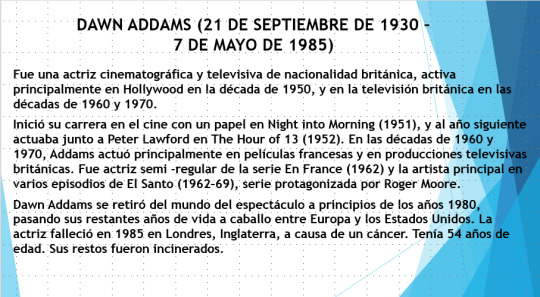
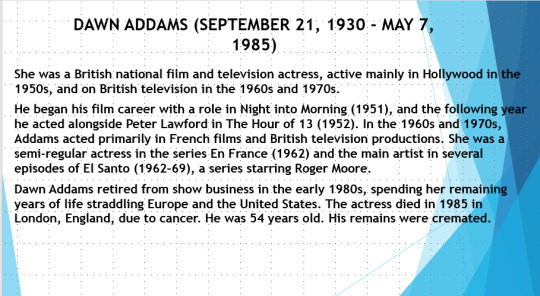
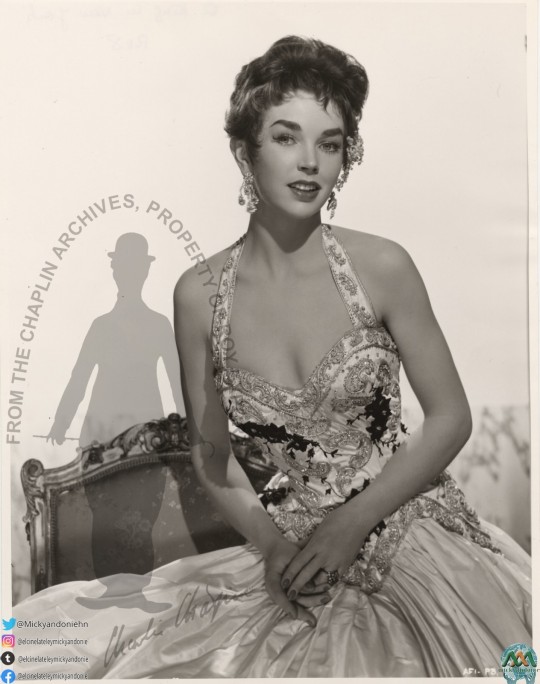
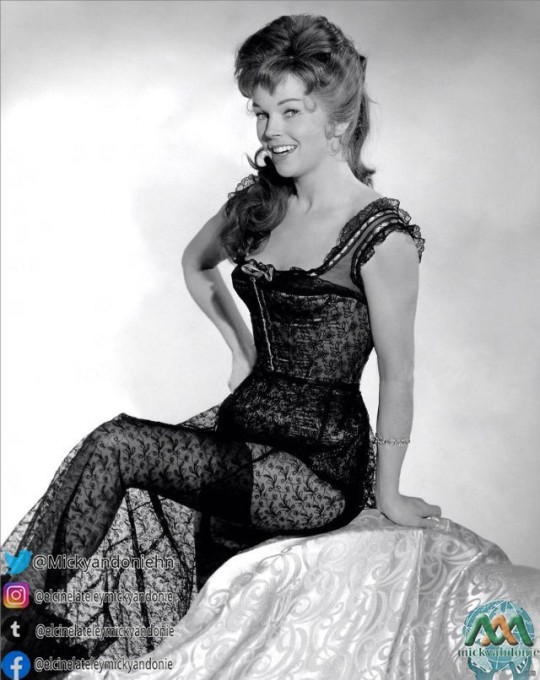
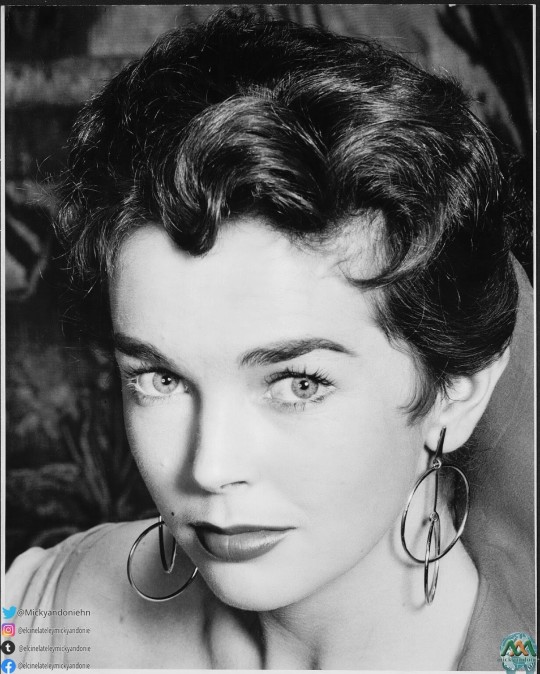

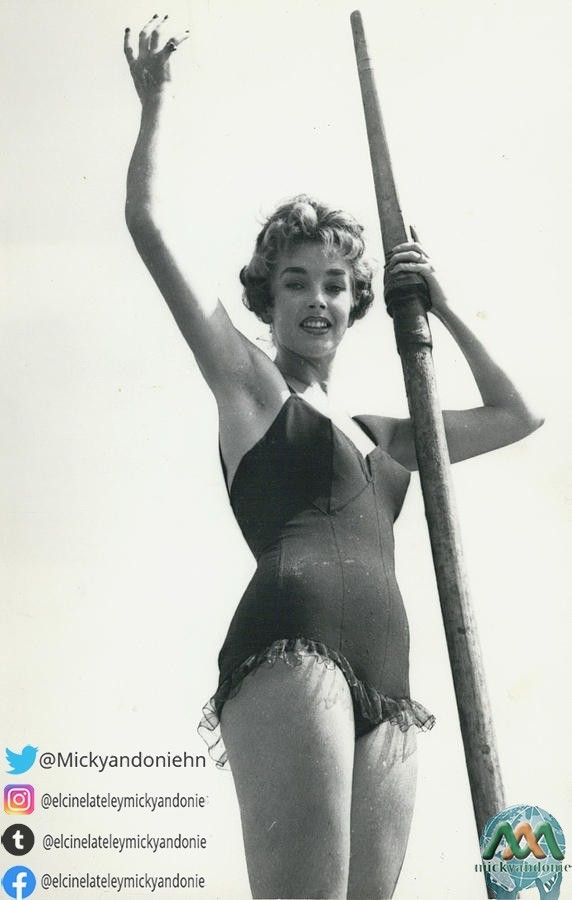

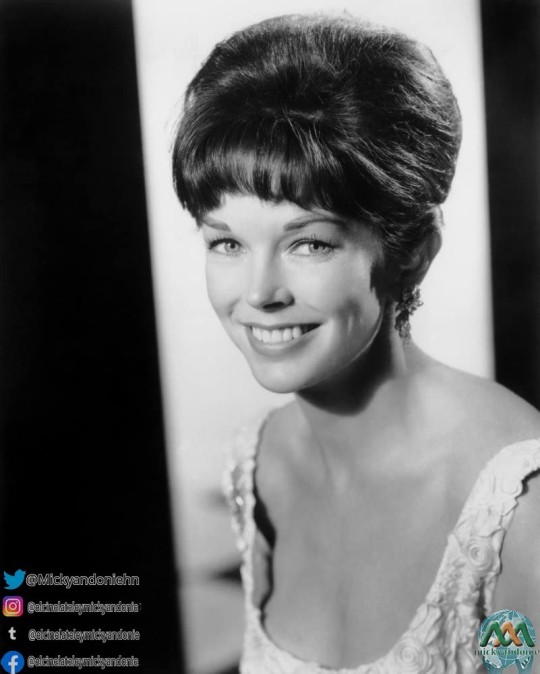
DAWN ADDAMS.
Filmography
1951: Night into Morning
1951: The Unknown Man
1952: Singing in the Rain
1952: The Hour of 13
1952: Plymouth Adventure
1953: Young Bes
1953: The Moon Is Blue
1953: Die Jungfrau auf dem Dach
1953: The Robe
1954: Riders to the Stars
1954: Mizar (Sabotaggio in mare
1954: Secrets d'alcôve, episode Divorces him
1954: Return to Treasure Island
1954: Khyber Patrol
1954: Il visconte di Bragelonne
1955: Il tesoro di Rommel
1955: I quattro del getto thunder
1957: Le avventure dei tre moschettieri
1957: A King in New York
1958: Londra chiama Polo Nord
1958: The Silent Enemy
1959: I battellieri of the Volga
1959: Die feuerrote Baronesse
1959: L'île du bout du monde
1959: Pensione Edelweiss
1959: The Treasure of San Teresa
1959: Geheimaktion schwarze Kapelle
1959: Secret Professionnel
1959: Voulez-vous danser avec moi?
1960: Die zornigen jungen Männer
1960: Die 1000 Augen des Dr. Mabuse
1960: The Two Faces of Dr. Jekyll
1961: Follow That Man
1961: Les menteurs
1962: L'éducation sentimentale
1963: Come fly with me
1964: The black tulip
1964: Ballad in Blue
1966: Where the Bullets Fly
1970: The Vampire Lovers
1971: Sapho ou La fureur d'aimer,
1973: Zeta One
1973: The Vault of Horror.
Créditos: Tomado de Wikipedia
https://es.wikipedia.org/wiki/Dawn_Addams
0 notes